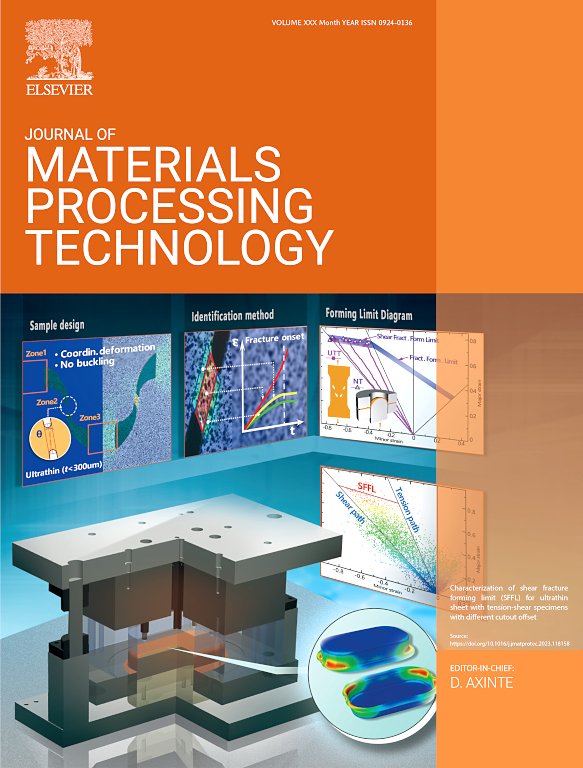用于预测离散极限应变和评估法向应力对成形极限影响的扩展中观 M-K 模型
IF 6.7
2区 材料科学
Q1 ENGINEERING, INDUSTRIAL
Journal of Materials Processing Technology
Pub Date : 2024-10-03
DOI:10.1016/j.jmatprotec.2024.118609
引用次数: 0
摘要
由于尺寸效应,金属板的可成形性降低,极限应变点的分布更加分散。这给微型零件的工艺设计和制造带来了巨大挑战。本文提出了一种基于 M-K 模型的改进型中观尺度成形极限模型。该模型将成形极限曲线 (FLC) 扩展到成形极限带,以预测极限应变的离散性。此外,还提出了一种施加法向应力以提高金属薄板成形极限的方法。通过法向应力下的单轴拉伸实验,评估并量化了法向应力对金属薄片表面粗化和流动应力的影响。结果表明,法向应力抑制了表面粗糙度的增加,提高了加工硬化率。利用构建的模型得出了法向应力对成形极限的影响。结果表明,所建模型的预测几乎包含了所有极限应变点。与单一的成形极限曲线相比,成形极限带更具包容性和安全性。此外,薄板在法向应力作用下的成形极限显著提高,这归因于表面粗化的抑制和应变硬化指数的提高。本文提出的成形极限带为金属薄板的成形极限评估提供了一种更可靠的形式。本文提出的施加法向应力的方法为解决金属薄板成形性差的难题提供了一条稳健而廉价的工艺路线。本文章由计算机程序翻译,如有差异,请以英文原文为准。
An extended mesoscaled M-K model for predicting discrete ultimate strains and evaluating the effect of normal stress on forming limits
Due to the size effect, the formability of metal sheets diminishes and the ultimate strain points exhibit a more discrete distribution. This poses a huge challenge to the process design and manufacture of microparts. This paper presents a modified mesoscopic scale forming limit model based on the M-K model. The model extends the forming limit curve (FLC) into forming limit bands to predict the discrete nature of the ultimate strain. In addition, a method for applying normal stresses to increase the forming limit of thin metal sheets is proposed. The effects of normal stresses on surface roughening and flow stresses in thin metal sheets were evaluated and quantified by uniaxial tensile experiments under normal stresses. The results show that the normal stress suppresses the increase of surface roughness and improves the work hardening rate. The effect of normal stresses on forming limits was obtained using a constructed model. The results show that the predictions of the proposed model are able to include almost all the ultimate strain points. The forming limit bands are more inclusive and safer than the single forming limit curve. In addition, the forming limits of thin plates under normal stresses are significantly increased, which is attributed to the suppression of surface roughening and the increase of strain hardening index. The forming limit bands proposed in this paper provide a more reliable form of forming limit assessment for thin metal plates. The proposed method of applying normal stresses provides a robust and inexpensive process route to address the challenge of poor formability of thin metal sheets.
求助全文
通过发布文献求助,成功后即可免费获取论文全文。
去求助
来源期刊

Journal of Materials Processing Technology
工程技术-材料科学:综合
CiteScore
12.60
自引率
4.80%
发文量
403
审稿时长
29 days
期刊介绍:
The Journal of Materials Processing Technology covers the processing techniques used in manufacturing components from metals and other materials. The journal aims to publish full research papers of original, significant and rigorous work and so to contribute to increased production efficiency and improved component performance.
Areas of interest to the journal include:
• Casting, forming and machining
• Additive processing and joining technologies
• The evolution of material properties under the specific conditions met in manufacturing processes
• Surface engineering when it relates specifically to a manufacturing process
• Design and behavior of equipment and tools.
 求助内容:
求助内容: 应助结果提醒方式:
应助结果提醒方式:


